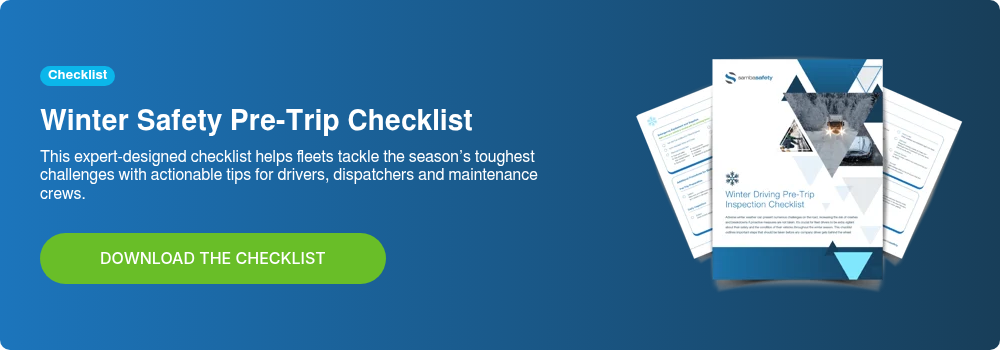Are Your Drivers Winter Driving Safety Experts? Share Our Quiz With Your Team

When fleet drivers are out on the road, it’s critical that they make the right decisions at the right time — especially when dangerous winter weather is at play.
How sharp are your team’s winter driving skills? Share this 10-question quiz with your drivers to see how they stack up. We’ve included answers and explanations at the bottom of the page (no peeking!).
Winter Driving Safety Quiz for Fleets
1) True or False: Reducing tire air pressure improves traction.
A) True
B) False
2) From November to March, when are fatal crashes most likely to occur?
A) Between 6 and 10 a.m.
B) Between 8 a.m. and noon
C) Between 8 p.m. and 12 a.m.
D) Between 4 and 8 p.m.
3) Of these four leading causes of vehicle skid, which is the most common?
A) Driving too fast
B) Excessive braking/rapid deceleration
C) Over-steering
D) Over acceleration
4) What should drivers do if their vehicle starts to skid?
A) Brake lightly, ease off the accelerator, steer towards a reference point and into the skid
B) Ease off the accelerator, steer toward a reference point and into the skid
C) Honk the horn to alert others and steer away from oncoming traffic
5) Where is black ice most likely to form?
A) At the top of a hill
B) On lesser-used roads
C) On bridges and in shady areas
D) In parking lots and driveway
6) In winter, drivers should never let the fuel level in their vehicle drop below…
A) 10%
B) 25%
C) 30%
7) When bad weather is in the forecast, what should drivers do every time they take a break or fuel up?
A) Check weather conditions
B) Ensure windows, lights and reflectors are free from snow, ice and grime
C) Check their hat hair
D) A & B
8) Weather-related crashes cause ____ injuries in the United States each year.
A) 560,000
B) 418,000
C) 320,000
9) When driving on snowy or icy roads, how much longer does it typically take to stop?
A) 3 times longer
B) 5 times longer
C) 10 times longer
D) 20 times longer
10) When driving on a wet road, drivers should reduce their speed by ____.
A) At least 10%
B) At least 15%
C) At least 25%
Winter Safety Quiz Answers
So, how’d you do? Check your answers below.
1). True or False: Reducing tire air pressure improves traction.
B) False. Reducing air pressure doesn’t improve traction, but it will reduce steering ability.
2) From November to March, when are fatal crashes most likely to occur?
D) Fatal crashes are most likely to occur between 4 and 8 p.m. Make sure you’re extra alert during the afternoon rush hour.
3) Of these four leading causes of vehicle skid, which is the most common?
A) Driving too fast. Going fast is easy — it’s stopping that’s a challenge.
4) What should drivers do if their vehicle starts to skid?
B) Drivers should ease off the accelerator, steer toward a reference point and into the skid. If the vehicle has a manual transmission, the driver can slowly depress the clutch pedal while slowly easing off the accelerator.
5) Where is black ice most likely to form?
C) On bridges and in shady areas.
6) In winter, drivers should never let their fuel level drop below…
B) 25%. Ideally, drivers should fuel up every night! A full tank will reduce condensation that can plug up a fuel line, and if conditions worsen during the trip, drivers won’t have to worry about running out of gas.
7) When bad weather is in the forecast, what should drivers do every time they take a break or fuel up?
D) Drivers should check weather conditions and the vehicle’s headlights and reflectors each time they exit their vehicles. Weather conditions can change — and change quickly — throughout the day. Additionally, snow, ice and road grime will accumulate even during short drives. Keeping lights and reflectors clean will help commercial drivers navigate tough conditions, remain visible to other drivers and avoid getting pulled over for a surprise DOT inspection.
8) Weather-related crashes cause ____ injuries in the United States each year.
B) Weather-related crashes cause approximately 418,000 injuries in the United States each year. Of these, snow and sleet account for approximately 18% of these crashes, while icy pavement and slushy roads cause 13% and 16% respectively.
9) When driving on snowy or icy roads, how much longer does it typically take to stop?
C) 10 times longer. Maintaining a safe distance at all times is key to preventing crashes.
10) When driving on a wet road, drivers should reduce their speed by ____.
C) At least 25%. If you’d drive 55 mph in ideal conditions, reduce speed to 40 mph when the road is wet.
Prepare for a Safer Winter Behind the Wheel
When drivers know how to make safe choices on the road, the likelihood of preventable crashes and claims decreases dramatically. Not sure how to weave winter safety into your existing safety strategy? We can help. Our free, expert-designed winter pre-trip inspection checklist can help your team prevent common winter incidents, minimize downtime and stay safe. It includes essential vehicle safety tips and a list of must-have supplies every driver should carry. Download and print your checklist below.




